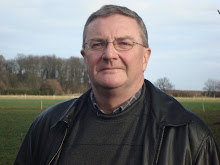This is Dryslwyn, one of the largest of the native Welsh castles, occupying a glorious hilltop position in the middle of the Towy Valley, half way between Carmarthen and Llandeilo. I was there earlier in the week, and was lucky to have excellent weather and the place virtually to myself. The castle dates from the first half of the thirteenth century, the period when the native rulers of Deheubarth (south-west Wales) were falling under the domination of the princes of Gwynedd. Dryslwyn is within sight of Dinefwr, the chief seat of the princes of Deheubarth, and was probably constructed by the same man responsible for the surviving structures there. It was enlarged in the 1280s by Rhys ap Maredudd, who was loyal to Edward I during the English campaign of conquest in 1282-3 but who rebelled in 1287, leading to a well-documented siege of the castle. The most dramatic incident during the siege was the collapse of a wall, killing several English noblemen; this was probably in the vicinity of the chapel tower, the building on the right in the general views of the castle. Dryslwyn also saw action in 1402-3 during the war of independence under Owain Glyndwr.
Dryslwyn Castle has been a particular favourite since my childhood, although that was long before it was placed under Cadw and properly excavated. Now, helpful display boards make it much easier to understand the complex layout of the castle, complicated by the fact that a small town lay outside the walls; the outlines of many of the small houses can still be seen on terraces running away along the sides of the hill to the north of the castle itself. There are some excellent descriptions of it accessible online, notably at the superb Castles of Wales website.
Dryslwyn, and the history of the princes of Deheubarth as a whole, has been comparatively neglected in fiction - something that I might set out to remedy one of these days! However, several scenes in Edith Pargeter's excellent 'Brothers of Gwynedd' series were set there, and in the nearby castles of Dinefwr and Carreg Cennen.
I'll include more of these potted accounts of castles from time to time in this blog; I've been an inveterate 'castle hunter' since the age of five, and have information on and photos of a large number of castles (not to mention churches and other historic sites) throughout the British Isles and beyond. Although this look at Dryslwyn is an exception, I'll try as far as possible to focus primarily on sites that currently have very little or no coverage on the Internet.
Subscribe to:
Post Comments (Atom)









No comments:
Post a Comment